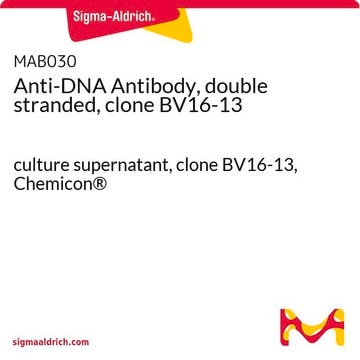04-1540
抗-PICH抗体,克隆142-26-3
clone 142-26-3, from mouse
别名:
excision repair cross-complementing rodent repair deficiency, complementation group 6-like, excision repair cross-complementing rodent repair deficiency complementation group 6 - like, Tumor antigen BJ-HCC-15, PLK1-interacting checkpoint helicase, ATP-de
登录查看公司和协议定价
所有图片(1)
About This Item
分類程式碼代碼:
12352203
eCl@ss:
32160702
NACRES:
NA.41
推荐产品
生物源
mouse
品質等級
抗體表格
purified immunoglobulin
抗體產品種類
primary antibodies
無性繁殖
142-26-3, monoclonal
物種活性
human
技術
immunocytochemistry: suitable
immunoprecipitation (IP): suitable
western blot: suitable
同型
IgG1κ
NCBI登錄號
UniProt登錄號
運輸包裝
wet ice
目標翻譯後修改
unmodified
基因資訊
human ... ERCC6L(54821)
一般說明
Plk1相互作用检查点螺旋酶(PICH)是纺锤体组装检查点(spindle assembly checkpoint)必不可少的成分(Baumann, C., et al. (2007).Cell 128:101–114)。该蛋白是ATP 酶家族SNF2成员,并可作为Plk1的结合伴侣和底物。 当PICH磷酸化时,它转化为Plk1,后者介导PICH的定位。作为DNA螺旋酶,PICH在前中期(prometaphase)的着丝点和著丝粒聚集,通过募集 MAD2和介导染色质着丝粒张力,成为纺锤体组装检查点的必要成分。PICH 的耗尽导致纺锤检查点的消除,引起染色体的大规模错误分离。
特異性
该抗体可识别Plk1相互作用检查点螺旋酶。
免疫原
组氨酸标记的重组蛋白,对应于人Plk1相互作用检查点螺旋酶(Plk1-interacting checkpoint helicase)。
表位:未知
應用
使用经 WB、IP、ICC验证的抗-PICCH抗体(克隆 142-26-3 )(小鼠单克隆抗体)来检测 PICCH(也称肿瘤抗原BJ-HCC-15、PLK1相互作用检查点螺旋酶、ATP依赖解旋酶ERCC6)。
免疫沉淀分析: 一个代表性批次已在一个独立实验室中进行了IP测试。
免疫细胞化学分析: 一个代表性批次已被独立实验室用于IC。
免疫细胞化学分析: 一个代表性批次已被独立实验室用于IC。
研究子类别
细胞周期,DNA 复制&修复
细胞周期,DNA 复制&修复
研究类别
表观遗传学&核功能
表观遗传学&核功能
品質
通过蛋白质印迹法在HeLa-S3细胞裂解液中进行了评估。
蛋白质印迹分析:0.1 µg/ml该抗体在10 µg的HeLa-S3细胞裂解液中检测到Plk1相互作用检查点螺旋酶。
蛋白质印迹分析:0.1 µg/ml该抗体在10 µg的HeLa-S3细胞裂解液中检测到Plk1相互作用检查点螺旋酶。
標靶描述
观测分子量〜160 kDa
外觀
形式:纯化
纯化的小鼠单克隆IgG1κ溶于含0.1 M Tris-甘氨酸(pH 7.4),150 mM NaCl和0.05%叠氮化钠的缓冲液中。
蛋白G纯化
儲存和穩定性
自收到之日起,在2-8°C条件下可稳定保存1年。
分析報告
对照
HeLa-S3细胞裂解液
HeLa-S3细胞裂解液
其他說明
浓度:请参考批次特异性浓缩物的检验报告。
免責聲明
除非我们的产品目录或产品附带的其他公司文档另有说明,否则我们的产品仅供研究使用,不得用于任何其他目的,包括但不限于未经授权的商业用途、体外诊断用途、离体或体内治疗用途或任何类型的消费或应用于人类或动物。
Not finding the right product?
Try our 产品选型工具.
儲存類別代碼
12 - Non Combustible Liquids
水污染物質分類(WGK)
WGK 1
閃點(°F)
Not applicable
閃點(°C)
Not applicable
Lotte P Watts et al.
eLife, 9 (2020-11-04)
Human cells lacking RIF1 are highly sensitive to replication inhibitors, but the reasons for this sensitivity have been enigmatic. Here, we show that RIF1 must be present both during replication stress and in the ensuing recovery period to promote cell
Christian F Nielsen et al.
Cell cycle (Georgetown, Tex.), 15(20), 2704-2711 (2016-08-28)
PICH is an SNF2-family DNA translocase that appears to play a role specifically in mitosis. Characterization of PICH in human cells led to the initial discovery of "ultra-fine DNA bridges" (UFBs) that connect the 2 segregating DNA masses in the
Stefano Santaguida et al.
Developmental cell, 41(6), 638-651 (2017-06-21)
Aneuploidy, a state of karyotype imbalance, is a hallmark of cancer. Changes in chromosome copy number have been proposed to drive disease by modulating the dosage of cancer driver genes and by promoting cancer genome evolution. Given the potential of
Christoph Baumann et al.
Cell, 128(1), 101-114 (2007-01-16)
We identify PICH (Plk1-interacting checkpoint "helicase"), a member of the SNF2 ATPase family, as an interaction partner and substrate of Plk1. Following phosphorylation of PICH on the Cdk1 site T1063, Plk1 is recruited to PICH and controls its localization. Starting
Kate Beishline et al.
Nature communications, 8(1), 2114-2114 (2017-12-14)
Telomere repeat DNA forms a nucleo-protein structure that can obstruct chromosomal DNA replication, especially under conditions of replication stress. Transcription of telomere repeats can initiate at subtelomeric CTCF-binding sites to generate telomere repeat-encoding RNA (TERRA), but the role of transcription
我们的科学家团队拥有各种研究领域经验,包括生命科学、材料科学、化学合成、色谱、分析及许多其他领域.
联系技术服务部门








